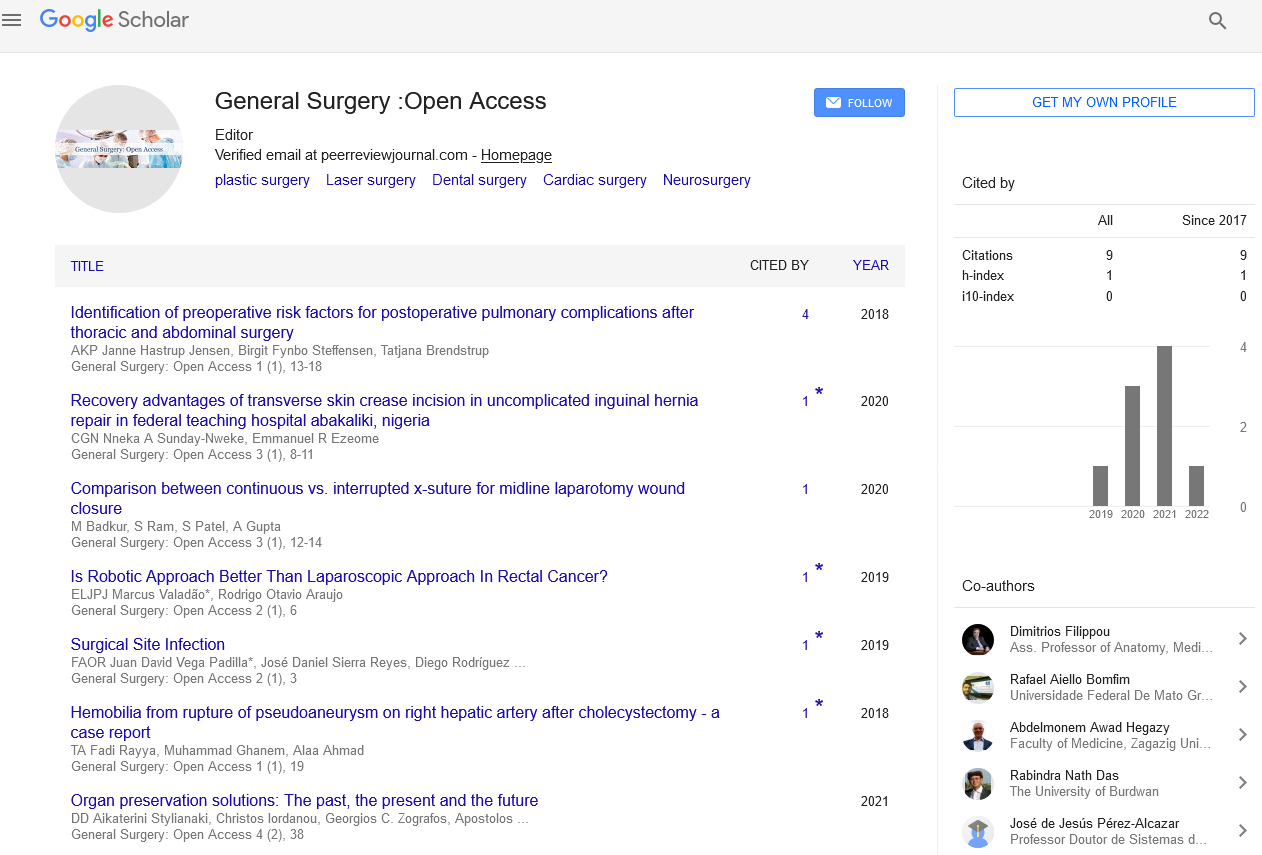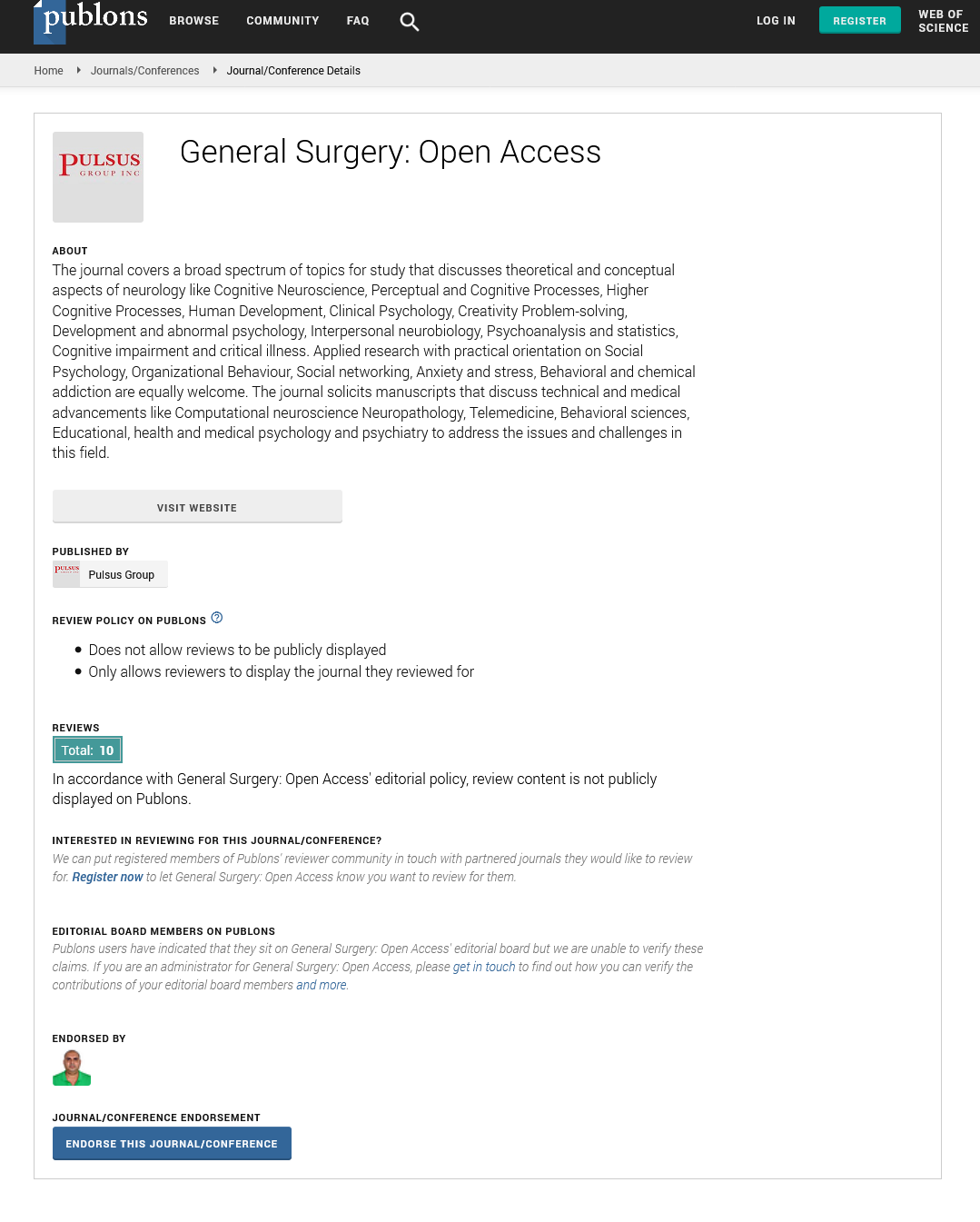The principles of dental surgery
Received: 04-Mar-2021 Accepted Date: Mar 18, 2021; Published: 26-Mar-2021
Citation: Schober S. The principles of dental surgery. Gen Surg: Open Access. 2021;4(2):6.
This open-access article is distributed under the terms of the Creative Commons Attribution Non-Commercial License (CC BY-NC) (http://creativecommons.org/licenses/by-nc/4.0/), which permits reuse, distribution and reproduction of the article, provided that the original work is properly cited and the reuse is restricted to noncommercial purposes. For commercial reuse, contact reprints@pulsus.com
Description
Dental surgery under General Anesthesia (GA) is a common treatment for severe childhood caries and thus may serve as an event to motivate behaviour change. The frequency of recurrent caries, however, indicates opportunities within current practice to change a child's oral health behaviours. Dental surgery is any of a number of medical procedures that involve artificially modifying dentition; in other words, surgery of the teeth, gums and jaw bones.
Community water fluoridation (CWF) is the most effective and cost-efficient dental public health intervention. Fluoridation of drinking water is among the top 10 US public health achievements of the 20th century. The use of CWF for population oral health has been associated with lower rates of caries, particularly in primary teeth. Regional studies have shown an association of CWF with reducing disease severity, which, in turn, is associated with utilization of caries-related procedures among residents aged 0 to 21 years. The timing of exposure to CWF is critical. Exposure in early childhood substantially reduces caries disease burden, not only during childhood but throughout the life span, with an exposure-response effect.
However, the potential adverse outcomes of early childhood exposure to fluoridated water are controversial. Childhood exposure to fluoridated water has been associated with attention-deficit/hyperactivity disorder in the US. The recently described association of in utero exposure to fluoridated water with childhood neurodevelopmental issues8 is balanced by criticisms of study limitations and prior studies that refute the associations between fluoride and neurodevelopmental outcomes. Although the causal link between CWF and neurodevelopment and behaviour disorders remains to be determined, fluoride’s benefits in preventing caries are better established. What is unknown is the extent to which CWF, an effective population-level preventive intervention, can reduce severe early childhood caries (S-ECC) and its associated treatments. The development of S-ECC is associated with a child’s social determinants of oral health, which reflect factors related to the child’s environment and the family’s oral health beliefs, behaviors, and parent-child personal dynamics. Provision of general anesthesia has been recognized as a necessary service to facilitate dental treatments in patients who require extensive treatment, have special health care needs, and/or experience acute situational anxiety, which is often the case in children with S-ECC. In the US, dental operations performed under general anesthesia (DGAs) represent a significant financial burden to public insurance programs such as Medicaid, which provides health care coverage for lowincome children and adults, with state-level variations in eligibility. Under the Early and Periodic Screening, Diagnosis, and Treatment Program, Medicaid covers DGA events for select children. Therefore, DGA events do not pose great financial stress to families. However, on the health care system level, Medicaid expenditures on pediatric hospital and ambulatory surgery center–based DGA have been estimated to be approximately $450 million. Total Medicaid expenditures are likely much higher, because officebased DGAs account for 40% to 75% of all DGA events in some states. Furthermore, provision of general anesthesia to young children has been scrutinized because of a 2015 US Food and Drug Administration warning on the use of commonly used anesthetic agents, which may not be supported in the translation from basic science to clinical trials. The objective of this study is to determine whether access to CWF is associated with the prevalence of DGA events among young Medicaid-enrolled children across 5 states.
Dentists inject anesthetic to block sensory transmission by the alveolar nerves. The superior alveolar nerves are not usually anesthetized directly because they are difficult to approach with a needle. For this reason, the maxillary teeth are usually anesthetized locally by inserting the needle beneath the oral mucosa surrounding the teeth. The inferior alveolar nerve is probably anesthetized more often than any other nerve in the body. To anesthetize this nerve, the dentist inserts the needle somewhat beyond the patient’s last molar.






